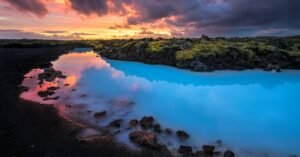Located in the heart of the North Atlantic, Iceland has always fascinated adventurers and nature lovers. This Nordic island country is famous for its breathtaking landscapes. But why is Iceland called the land of fire and Ice?
To understand the charm of Iceland, we need to grasp its unique geology. The country’s geothermal activity, caused by its position on the Mid-Atlantic Ridge, creates a remarkable contrast between fiery volcanoes and icy glaciers. These opposing forces have shaped a truly one-of-a-kind landscape.
Iceland’s fiery nature is evident in its many volcanoes, with Eyjafjallajökull and Hekla being notable examples. These majestic mountains, covered in snow, occasionally awaken to remind us of their immense power. At the same time, large ice caps like Vatnajökull and Langjökull cover the land, their icy extensions reaching out majestically.
This unique combination of fire and ice has given Iceland its distinct identity, offering a stunning canvas for exploration and discovery. Join us as we embark on a journey to uncover the mysteries of Iceland and reveal why it truly deserves to be called the Land of Fire and Ice.

Contents
Why is Iceland Called the Land of Fire and Ice?
Iceland is known as the “Land of Fire and Ice” because of its special mix of volcanic activity and icy landscapes. The island is located on the Mid-Atlantic Ridge, where the Eurasian and North American tectonic plates come together. This creates frequent volcanic eruptions and geothermal action. The volcanic activity makes the environment hot, with lava fields, geysers, and bubbling hot springs.
Meanwhile, Iceland is also home to huge ice caps and glaciers that cover a big part of the land. These icy formations offer amazing views of ice caves, glacier lagoons, and impressive icebergs. The contrast between the hot and ice volcanic areas makes Iceland truly fascinating. The name “Land of Fire and Ice” perfectly captures Iceland’s geology’s dynamic and awe-inspiring natural wonders.
The Volcanic Power 
Iceland sits atop the Mid-Atlantic Ridge, a volatile tectonic boundary where the Eurasian and North American plates meet. This unique geological position exposes the island to intense volcanic activity, making it a hotbed for volcanic wonders. The fiery eruptions and molten lava flows contribute significantly to Iceland’s fiery reputation.
The most famous volcano in recent history is Eyjafjallajökull, which erupted in 2010 and caused massive disruptions to air travel across Europe. This event put Iceland in the global spotlight, showcasing its volcanic activity’s destructive power and mesmerizing beauty.
You can also checkout, Are Chacos good for hiking?
The Glacial Majesty 
Alongside the fiery volcanoes, Iceland is home to magnificent glaciers covering approximately 11% of its landmass. These massive ice formations, such as Vatnajökull, Langjökull, and Snæfellsjökull, carve out breathtaking landscapes, including ice caves and glacial lagoons.
One of Iceland’s most iconic glacial features is Jökulsárlón, a stunning glacial lagoon dotted with shimmering icebergs. It provides a surreal experience for visitors who can witness the surreal sight of icebergs floating gracefully in the turquoise waters, creating a truly magical ambiance.
Geothermal Wonders: Where Fire and Ice Unite
The Blue Lagoon 
When thinking of Iceland’s geothermal marvels, the Blue Lagoon is undoubtedly the first that comes to mind. This otherworldly geothermal spa is located in a lava field on the Reykjanes Peninsula, renowned for its milky blue waters and therapeutic properties. The lagoon’s warm and mineral-rich waters create a unique and rejuvenating experience, inviting visitors to unwind amidst a surreal volcanic landscape.
The Earth’s Showmanship 
Iceland’s geothermal activity provides a fascinating show of nature’s power with its geysers. Geysir, The most well-known geyser, has been shooting water into the air for hundreds of years. While Geysir is not as active now, its neighbor, Strokkur, steals the spotlight by erupting every few minutes, sending hot water high up in the sky. This geothermal display demonstrates how fire and ice coexist harmoniously in Iceland’s incredible geology.
A Photographer’s Paradise 
Iceland has stunning landscapes that offer countless opportunities for photography. You can find dramatic black sand beaches like Reynisfjara and beautiful mountains like Kirkjufell.
Photographers from all over the world come to Iceland to capture its natural beauty. They want to preserve the unique combination of fire and ice that makes this land special. The ever-changing weather and how light and shadows interact add depth and mystery to photos. Iceland is truly a paradise for those who appreciate art and photography.
Iceland’s Unique Cultural Heritage
Beyond its breathtaking natural landscapes, Iceland boasts a rich and unique cultural heritage shaped by centuries of isolation, Norse traditions, and artistic expressions.
Norse Mythology and Sagas
Iceland’s rich cultural heritage is deeply intertwined with Norse mythology and sagas. The ancient sagas, written in Old Norse, depict the lives and adventures of legendary Viking heroes. These sagas are captivating literary works and provide insights into Iceland’s early history, societal structures, and values.
Exploring the country, visitors can uncover sites of historical significance, such as Thingvellir National Park, where the world’s oldest functioning parliament was established in 930 AD. The park also holds geological importance, as it lies within the rift valley between the Eurasian and North American tectonic plates.
Creative Arts and Literature
Iceland has a strong literary culture. People in Iceland enjoy reading and writing. They have a long tradition of telling stories, and they publish a lot of books. Reykjavik, the capital of Iceland, became a UNESCO City of Literature in 2011. This shows how important literature is to the city.
Icelandic music is also becoming popular around the world. Bands like Sigur Rós and Of Monsters and Men are attracting fans from different countries. The music often reflects the beautiful landscapes of Iceland, creating a nice connection between art and nature.

Tourism and Adventure in Iceland
Opportunities for Hiking and Trekking
Iceland offers incredible opportunities for hiking and trekking enthusiasts. There are many different types of landscapes to explore, from strenuous hikes across lava fields to tranquil strolls close to glacial lagoons. Immerse yourself in the natural beauty of the country.
Glacier Tours and Ice Climbing
Discover the wonders of Iceland’s icy landscapes with guided glacier tours. Experience the thrill of ice climbing as you ascend frozen walls and navigate crevasses within the glaciers.
Northern Lights Viewing
Iceland’s location near the Arctic Circle makes it a perfect destination to witness the fascinating phenomenon of the Northern Lights. The enchanting dance of the aurora borealis against the dark winter skies of Iceland creates a truly magical experience.
Whale Watching
Iceland’s coastal waters are abundant with diverse marine life, making it an excellent location for whale watching. Join boat tours to spot magnificent creatures like humpback whales, orcas, and dolphins and create unforgettable memories.
To Sum It Up
Iceland is rightly called the “Land of Fire and Ice” because it is home to some incredible natural wonders. The country’s volcanoes are a sight to behold, with their powerful eruptions and mesmerizing lava flows. The glaciers, on the other hand, are massive ice sheets covering the land, creating breathtaking landscapes.
Iceland’s waterfalls are also a major attraction, with their cascading waters and beautiful surroundings. The geothermal activity in the country is another fascinating aspect, with hot springs and geysers that showcase the Earth’s natural heat.
In addition to its natural beauty, Iceland has a rich cultural heritage. The people take great pride in their traditions, folklore, and literature. Traditional festivals and celebrations give visitors a chance to experience Icelandic culture firsthand.
Visiting Iceland means immersing yourself in a world of contrasting elements. You can witness the power of nature in the volcanoes and glaciers, relax in the warm waters of a hot spring, and explore the unique cultural traditions of the Icelandic people.







